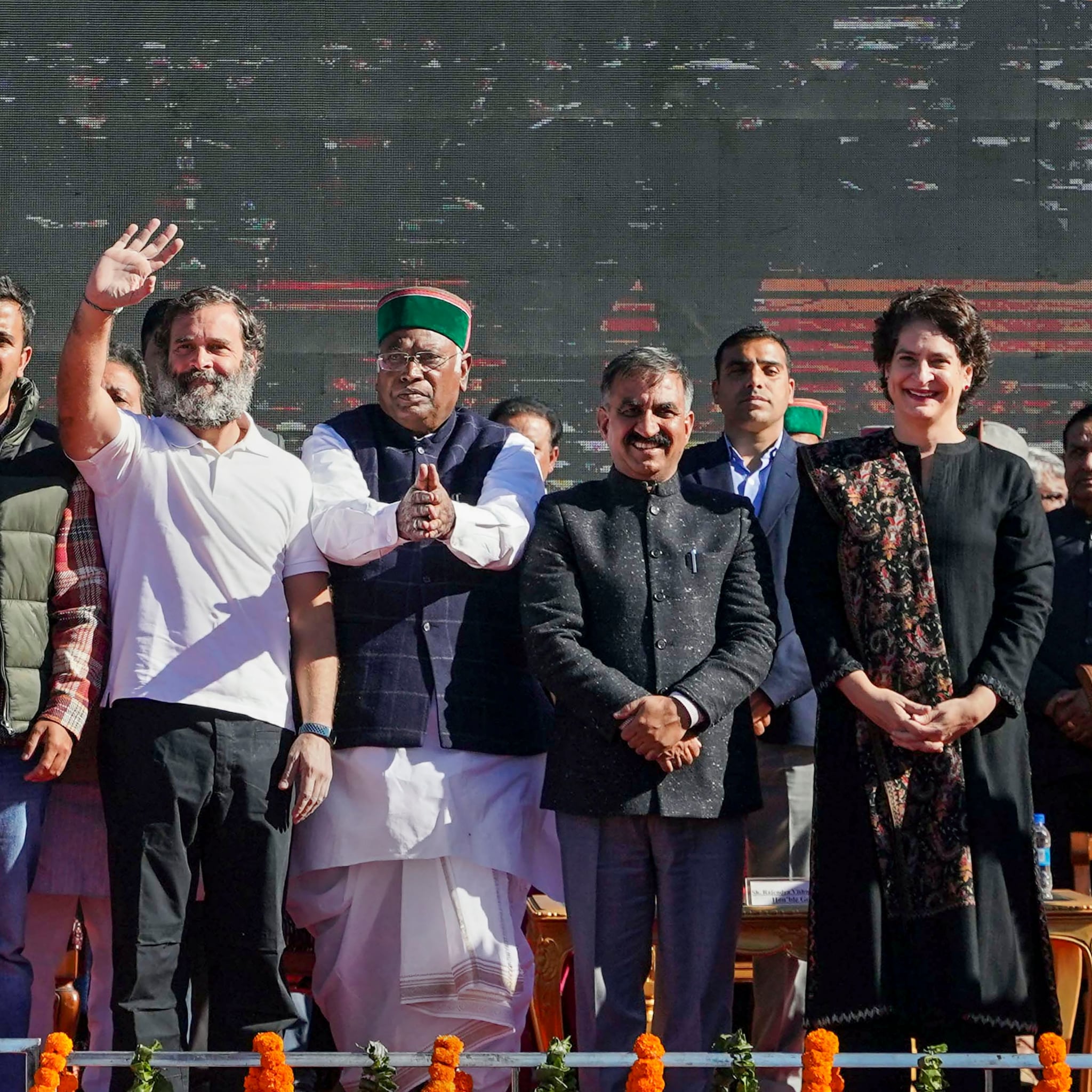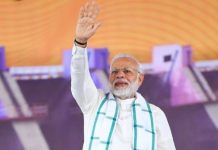
The BJP’s landslide victory in Gujarat has bolstered its confidence of retaining power in 2024. However, the Congress win in Himachal Pradesh has negated the myth that the BJP is invincible and showed that PM Modi’s personal appeal has its limitations. A report by Amit Agnihotri
As 2022 came to an end, all the three parties, BJP, Congress and AAP had reasons to welcome 2023 with a smile.
The reason was that the BJP registered a record win in Gujarat by winning 156 out of 182 seats, the Congress won Himachal Pradesh by bagging 40 out of 68 seats and the AAP became a national party by winning 5 seats and 13 percent vote share in Gujarat, besides ending the saffron party’s 15-year rule in Delhi municipal polls.
The Gujarat and Himachal Pradesh polls were watched keenly across the country as they would have a bearing on the Madhya Pradesh, Karnataka, Rajasthan and Chhattisgarh assembly in 2023, ahead of the 2024 national polls.
Going by the Gujarat result, in which PM Modi’s personal appeal and the BJP’s better election machinery made all the difference, many in the saffron party have started claiming a third term for him at the Centre.
However, the Himachal Pradesh result negated the myth that the BJP is invincible and showed that PM Modi’s personal appeal had its limitations.
For the Congress, which is conducting a nationwide yatra to revive the party ahead of 2024 national polls, the Himachal Pradesh win came as a morale booster but its worst ever performance in Gujarat elections showed that the road ahead for the grand old party’s resurgence was a long one.
Gujarat is a bigger state which sends 26 seats to the Lok Sabha against Himachal Pradesh, which has only 4 parliamentary seats.
The AAP had claimed it would defeat BJP in Gujarat and emerge as the national replacement of the Congress in 2024 but the zero seats in Himachal Pradesh and just 5 in Gujarat showed that mere hype would not change the ground reality for the new party.
The poor performance of AAP showed that there was little scope for a third force in the two states where the main fight would continue to be between BJP and Congress.
Congress
The grand old party ran a low-key campaign in Himachal Pradesh while highlighting the various guarantees it had given to the voters.
Rahul Gandhi did not campaign as he was busy with the Bharat Jodo Yatra but made an appeal to the voters on the voting day November 12.
Priyanka Gandhi Vadra led the party’s campaign along with Chhattisgarh chief minister Bhupesh Baghel and Sachin Pilot while Congress president Mallikarjun Kharge also held rallies in Himachal.
Later, Congress leaders credited Priyanka Gandhi Vadra for the good showing in the Himachal assembly elections. This was Priyanka Gandhi’s first electoral success after the party had lost Uttar Pradesh assembly polls while she spearheaded the canvassing there earlier this year.
The Congress had brought in a new team in the hill state last year headed by AICC in charge Rajeev Shukla who opted for Pratibha Singh, wife of former chief minister Virbhadra Singh, as state unit chief to win back the state.
The grand old party was affected by infighting and defections in the hill state but factions of state unit chief Pratibha Singh and senior leaders Mukesh Agnihotri and Sukhvinder Sukhu stayed together.
After the polls, there was a tussle between Pratibha Singh and Sukhu but the latter was finally named the Himachal Pradesh chief minister with Agnihotri as his deputy. Kharge, Rahul and Priyanka attended Sukhu’s oath taking ceremony in a show of strength.
Pratibha Singh, the sitting Lok Sabha member from Mandi, a seat which fell vacant after her husband and former chief minister Virbhadra Singh’s death, accepted the high command’s decision gracefully.
However, Gujarat turned out to be a big disappointment for the Congress, which had been banking on the BJP’s huge 27-year anti-incumbency to stage a comeback in the western state.
After giving a tough fight to the BJP in the 2017 Assembly polls in Gujarat by winning 77 seats, the Congress hit rock bottom with just 17 seats. Both Kharge and Rahul Gandhi accepted the defeat with humility.
“We humbly accept the mandate of the people of Gujarat. We will reorganize, work hard and continue fighting for the ideals of the country as well as the rights of the people of the state,” Rahul Gandhi said in a tweet in Hindi.
“The Gujarat results are disappointing. We need to introspect, take tough decisions and develop new leadership in the state,” Jairam Ramesh said.
He blamed the AAP and AIMIM for helping the BJP win in the western state.
Earlier, the party was affected by infighting as several of its MLAs joined the BJP over the past few years. The notable shift was Hardik Patel.
AAP
The Aam Aadmi Party contested Himachal Pradesh assembly polls for the first time but drew a blank and got just 1 percent vote share. In many seats like Dalhousie, Kasumpti, Chopal, Arki, Chamba, and Churah, AAP candidates got less votes than ‘None of The Above’ NOTA option.
AAP had started its campaign in Himachal on a high note before the November 12 elections with party convener Arvind Kejriwal and Punjab Chief Minister Bhagwant Mann holding rallies and road shows but they soon gave up due to lack of response from the voters. The party contested 67 out of 68 seats in Himachal but could not win even a single seat.
In Gujarat, the AAP lacked a popular face as its chief minister nominee and had no party organization. To make up for this shortcoming, the party had to depend on paid workers and media hype to project itself as the party which could defeat the BJP.
Like the Congress, the AAP too had made several promises like free electricity, Rs 1,000 to women, jobs for youths, quality education and health facilities, and improvement in rural infrastructure to woo the Gujarat and Himachal voters.
The AAP got a 13 percent vote share in Gujarat which made it eligible to be recognised as a ‘state party’ by the Election Commission. Since Gujarat is the fourth state where the AAP got the ‘state party’ recognition, besides Delhi, Punjab and Goa, it will be eligible for a national party recognition as well.
After the Election Commission’s formal nod, the AAP will become the eighth party currently with national status, the others being Congress, BJP, Mayawati’s BSP, the Communist Party of India (CPI), the CPI (Marxist), Sharad Pawar’s Nationalist Congress Party and Mamata Banerjee’s Trinamool Congress.
AAP Rajya Sabha member Raghav Chadha said the Aam Aadmi Party gained the status of a national party within 10 years of its formation. He took potshots at the saffron party saying that the BJP had in fact lost two polls, Himachal and the Delhi municipal elections.
The Delhi MCD polls were held on Dec 4 along with that of Gujarat on Dec 1 and Dec 5 and put pressure on the AAP to manage both. Yet, Kejriwal’s promise to clean up Delhi in five years convinced the voters to give AAP a majority in the municipal body and end the BJP’s 15-year rule. The Congress remained a marginal player in the local body indicating the Delhi unit needed an overhaul.
BJP
The BJP celebrated its big win in Gujarat even as party chief JP Nadda attacked the AAP for challenging it there. PM Modi too targeted the new party without taking any names. “Those political parties that try to exploit the fault lines and pose new challenges to India from within just to make some political gains, those parties are being watched and understood by the people of the nation,” PM said.
“They might find a lot of things to exploit and divide the people, but there is one thing that unites us all – our motherland. And we in BJP work only for the benefit of the motherland. Today, BJP is the first choice of most people in India,” he said.
Former Gujarat chief minister Bhupendra Patel, who won by a record margin, was elected for a second term by the new MLAs. Interestingly, Patel was brought in only last year in place of former chief minister Vijay Rupani to curb anti-incumbency.
In Himachal Pradesh, the BJP had to deal with rebel candidates on 21 out of 68 seats. Further, despite being the home state of JP Nadda, presence of various party factions led by Nadda, Union minister Anurag Thakur, and Chief Minister Jairam Thakur affected the party. Also, while Gujarat does not send many soldiers, Himachal Pradesh is home to a large number of ex-servicemen families, who had been affected by the controversial “Agniveer” defence jobs scheme.
The hill state has a large number of people who prefer government jobs and the Congress’ promise of bringing back the Old Pension Scheme, made the voters shift towards the opposition party. The BJP’s claim of double engine governments did not appeal to the Himachal voters as they believed in the Congress allegation that no development took place in the past five years.
Former chief minister Jairam Thakur said his party would learn from the shortcomings while PM Modi noted the difference between vote shares of BJP and Congress was not much.












